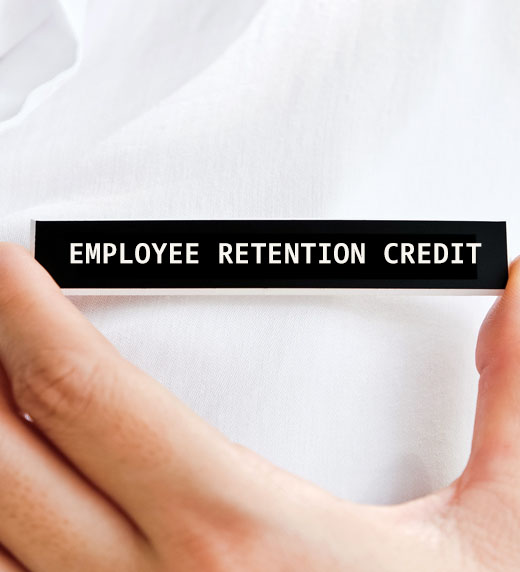Updated April 05, 2023
What Is the CARES Act?
On March 27, the president signed into law the Coronavirus Aid, Relief and Economic Security (CARES) Act. The $2
trillion legislative package to combat the coronavirus pandemic brings much needed economic relief to employers and
employees impacted by the
COVID-19 virus.
Below are the highlights for businesses and individuals.
Business Changes
Employee Retention Credit for employers
The CARES Act provides a refundable payroll tax credit for 50% of wages paid by eligible employers to certain
employees during the COVID-19 crisis. The credit is not available to employers receiving Small Business Interruption
Loans.
Delay of payment of employer payroll taxes
The CARES Act allows taxpayers to defer paying the employer portion of certain payroll taxes through the end of 2020.
The deferred amount is payable half on December 31, 2021, and half on December 31, 2022.
Modification of net operating losses (NOLs) incurred in 2018, 2019 and 2020
Repeals the 80% taxable income limitation for NOLs. NOLs from those years may also be carried back up to five years.
Corporate minimum tax credit (MTC) Is accelerated
The CARES Act allows corporations to claim 100% of AMT credits in 2019. It also provides for an election to take the
entire refundable credit amount in 2018.
Deductibility of interest expense
Section 163(j) generally limits the deduction of business interest expense to 30% of Adjusted Taxable Income (ATI).
For 2019, the 30% ATI limit is raised to 50%, but only for businesses NOT conducted as partnerships. Partnerships
must continue to use the 30% ATI limit for 2019. However, partners of partnerships who have disallowed interest
expense in 2019 (the disallowed portion is called Excess Business Interest, or EBI) may deduct 50% of the
partner’s share of disallowed 2019 EBI on the partner’s tax return for 2020, without regard to the limits of Section
163(j). For 2020, all businesses may utilize the 50% of ATI limit and may elect to use 2019 or 2020 ATI for this
calculation.
Bonus depreciation for qualified improvement (QI) property
The CARES Act provides a technical correction to the TCJA and specifically designates QI property as 15-year property
for depreciation purposes, which makes QI property a category eligible for 100% bonus depreciation. For prior years,
it is unclear whether to file amended returns or do a “catch-up” in the current year.
Special deductions
The CARES Act provides that the limitation on corporate charitable contributions is increased to 25% of the
corporation’s taxable income (previously 10% of taxable income).
Small business interruption loans
Small business interruption loans (see PPP
loans) were implemented to provide significant relief for small businesses substantially
affected by COVID-19 with potentially forgivable loans [Section 7(a) loans].
Eligible entities
- 500 or fewer employees (unless industry’s SBA size standard allows more than 500 employees)
- Small businesses, nonprofits and veterans’ organizations
- Sole proprietors, independent contractors and other self-employed individuals
- Businesses in certain industries (restaurant/hospitality) with more than one physical location and no more than
500 employees per location
- The affiliation rules are waived for businesses in the restaurant and hospitality industries and approved
franchises on the SBA’s Franchise Directory
Requirements
- Business must be operational on February 15, 2020
- Business paid employees’ salaries and payroll taxes or paid independent contractors
- Business was significantly impacted by COVID-19
- Borrowers certify to the lender, in good faith, to use funds to retain workers, maintain payroll and other
obligations, including mortgage payments, rent under a lease agreement and utilities
Loan terms
- Maximum loan is the lesser of (1) $10 million, OR (2) the average monthly payroll for the prior 12 months (prior
to the loan date, up to $100k salary prorated annually/EE ), times 2.5, OR (3) the outstanding amount of certain
SBA loan made on or after January 31, 2020
- Maximum maturity is 10 years
- Interest rate will not exceed 4%
- Any canceled indebtedness will not be included in taxable income
- Borrower supplies lender with the following:
- Application with number of full-time equivalent employees on payroll and other allowable costs
- Payroll tax filings
- State income, payroll and unemployment insurance filings
- Financial statements verifying payment on debt incurred before February 15, 2020
- Other documents that may be requested
Allowable use of funds
- Employee salaries, payroll support, paid sick or medical leave, group healthcare benefits
- Mortgage payments on debt obligation existing prior to February 15, 2020, rent under a lease agreement existing
prior to February 15, 2020
- Utilities
- Insurance premiums
- Other debt obligations incurred before February 15, 2020
Loan forgiveness
- Maximum forgivable amount is equal to the amount spent in 8-week period (after the loan origination date) on the
following items: payroll costs (up to $100K salary prorated annually/EE), interest payment on mortgages held
prior to February 15, 2020, rent payments (if lease in force prior to February 15, 2020), utility payments (if
service began prior to February 15, 2020).
- Amount forgiven will be reduced (1) proportionately to any reduction in number of employees retained compared to
number of employees existing in one of two testing periods, and (2) if there is any reduction in employee wages
greater than 25% (not including employees earning more than $100K salary prorated annually) during the most
recent full quarter.
- Borrowers that rehire employees previously laid off will not be penalized for reduced payroll.
- Amount not forgiven can be repaid over 10 years at a rate not to exceed 4%.
Other items
- Collateral and personal guarantees will be waived during the covered period.
- Borrower and lender fees for 7(a) loans will be waived.
Individual Changes
Emergency increase in unemployment compensation
Unemployment benefits increase by $600 a week for up to four months through July 31, 2020.
Recovery cash rebates
The CARES Act provides a credit of $1,200 ($2,400 for joint filers), plus $500 for each qualifying child, for 2020.
The phaseout of payment begins for adjusted gross income (AGI) level at $75,000 for single filers ($150,000 joint).
The credit phases out entirely at $99,000 ($198,000 for joint filers). An eligible individual is any individual who
has a Social Security number. Nonresident aliens are not eligible.
Required minimum distribution (RMD) rules
In general, a retirement plan participant or IRA owner who reaches age 72 is required to take RMDs annually. The
CARES Act has waived the RMD rules for the calendar year 2020 for IRAs and certain defined contribution plans.
Tax-favored withdrawals from retirement plans
The CARES Act removes the early withdrawal 10% tax penalty if the distribution from a qualified retirement plan made
in 2020 is considered a “coronavirus-related distribution.” The aggregate amount received by an
individual which can
be treated as a “coronavirus-related distribution” cannot exceed $100,000. The income from the
distribution is
spread ratably over 3 years. The income can be avoided if the distributions are repaid within 3 years from the date
of receipt.
The “coronavirus-related distribution” is defined by the CARES Act as a distribution to an individual
who:
- is diagnosed with COVID-19
- whose spouse or dependent is so diagnosed, or
- who experiences financial hardship as a result of being quarantined or other factors
The CARES Act increases the loans from qualified plans to $100,000 (from $50,000) in the first 180 days beginning on
the date of enactment of the Act.
Contribution deadline extended
The deadline for making 2019 individual retirement account (IRA), health savings account (HSA) and Archer medical
savings account (MSA) contributions are extended until July 15, 2020.
Charitable contribution
The CARES Act has increased the deduction percentage limitation for cash charitable contributions from 60% to 100% of
the taxpayer’s adjusted gross income for the 2020 tax year. Contributions to 509(a)(3) organizations and
donor-advised funds are not eligible. Only cash contributions made in the 2020 calendar year to an organization
described in Code Sec. 170(b)(1)(A) are eligible. Any unused excess contributions will be a carryover.
$300 above-the-line charitable deduction
Individuals who use the standard deductions instead of itemized deductions may now claim up to $300 of charitable
deduction to arrive at adjusted gross income on the 2020 tax return.
Limitation on business losses (Section 461(l))
The CARES Act removes the limitation on excess business losses for taxpayers other than corporations for tax years
beginning after December 31, 2017, and before January 1, 2021. The limitation reverts back to the $250,000
($500,000 joint return) limits established by TCJA starting 2021.
Nonprofit Changes
Charitable giving
Corporate deductions
The CARES Act increases the limitation on corporate charitable contributions to 25% of the corporation's taxable
income
(previously 10% of taxable income).
Individual contribution AGI limit increase
The CARES Act increases the deduction percentage limitation for cash charitable contributions from 60% to 100% of a
taxpayer's adjusted gross income for the 2020 tax year. Contributions to 509(a)(3) organizations and donor-advised
funds
are not eligible. Only cash contributions made in the 2020 calendar year to an organization described in Code Sec.
170(b)(1)(A) are eligible, which excludes most private foundations. Any unused excess contributions will be allowed
as a
5-year carryover.
$300 above-the-line charitable deduction
Individuals who use the standard deduction instead of itemized deductions may now claim up to a $300 charitable
contribution deduction to arrive at adjusted gross income on their 2020 tax return.
Employment taxes
Employee retention credit for employers
The CARES Act provides a refundable payroll tax credit for 50% of wages paid by eligible employers to certain
employees
during the COVID-19 crisis. The credit is not available to employers receiving Small Business Interruption Loans.
Delay of payment of employer payroll taxes
The CARES Act allows taxpayers to defer paying the employer portion of certain payroll taxes through the end of 2020.
Half of the deferred amount is payable on December 31, 2021, and half on December 31, 2022. The deferral may not be
available to employers who received Paycheck Protection Program loan forgiveness.
Small business interruption loans
These were implemented to provide significant relief for small businesses substantially affected by COVID-19 with
potentially forgivable loans ("Section 7(a) loans" or "Paycheck Protection Program loans").
Eligible nonprofit entities
- Generally, organizations with 500 or fewer employees (unless the industry's SBA size standard allows more than
500
employees)
- 501(c)(3) organizations, veterans' organizations, and Tribal business concerns described in section 31(b)(2)(C)
- The affiliation rules may apply
Requirements
- Business must have been operational on February 15, 2020
- Business paid employees' salaries and payroll taxes or paid independent contractors
- Business was significantly impacted by COVID-19
- Borrowers certify to the lender, in good faith, to use funds to retain workers, maintain payroll and other
obligations
including mortgage payments, rent under a lease agreement, and utilities
Loan terms
- Maximum loan is the lesser of the following options:
- $10 million, OR
- The average monthly payroll for the prior 12 months (prior to the loan date, up to $100K salary prorated
annually per
employee), times 2.5, OR
- The outstanding amount of certain SBA loans made on or after January 31, 2020
- Maximum maturity is 10 years
- Interest rate will not exceed 4%
- Any canceled indebtedness will not be included in unrelated business taxable income
- Borrower supplies lender with the following:
- Application with number of full-time equivalent employees on payroll and other allowable costs
- Payroll tax filings
- State income, payroll and unemployment insurance filings
- Financial statements verifying payment on debt incurred before February 15, 2020
- Other documents that may be requested
Allowable use of funds
- Employee salaries (up to $100,000 in annual salary), payroll support, paid sick or medical leave, group
healthcare
benefits
- Mortgage payments on debt obligation existing prior to February 15, 2020, or rent under a lease agreement
existing
prior to February 15, 2020
- Utilities
- Insurance premiums
- Other debt obligations incurred before February 15, 2020
Loan forgiveness
- Maximum forgivable amount is equal to the amount spent in the eight-week period after the loan origination date
on the
following items: payroll costs (not including employees earning more than $100K salary prorated annually),
interest
payment on mortgages held prior to February 15, 2020, rent payments (if lease in force prior to February 15,
2020),
utility payments (if service began prior to February 15, 2020)
- Amount forgiven will be reduced (1) proportionately to any reduction in number of employees retained compared to
number of employees existing in one of two testing periods, and (2) if there is any reduction in employee wages
greater
than 25% during the most recent full quarter for employees earning less than $100K annually
- Borrowers that rehire employees previously laid off will not be penalized for reduced payroll
- Amount not forgiven can be repaid over 10 years at a rate not to exceed 4%
Other items
- Collateral and personal guarantees will be waived during the covered period
- Borrower and lender fees for 7(a) loans will be waived
We're here to help
Reach out to our tax consulting team if you need further information on this topic.



